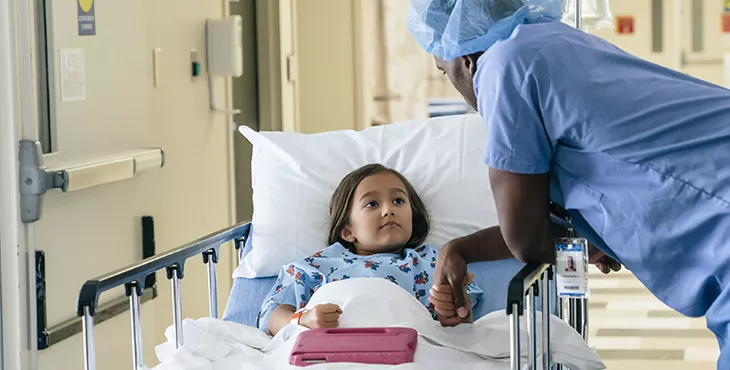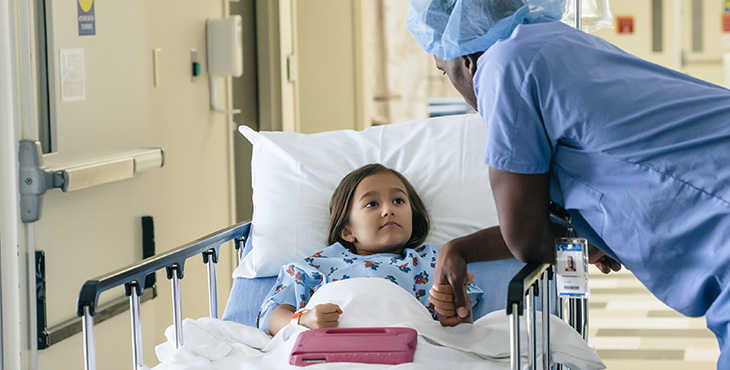Minimally-Invasive Surgery

About
Minimally-invasive surgery can offer patients many positive outcomes including less pain, shorter recovery time and a shorter length of stay in the hospital.
Laparoscopic surgery is used for many different types of treatment. With this type of surgery, a surgeon places a camera inside a patient’s body through several small incisions. This way, there is a smaller incision for the patient, but the surgeon can still see the way he or she could through a larger incision.
Robotic surgery is on the leading edge of surgical care. Surgeons use computer-guided tools to operate with unparalleled precision, dexterity and control enabling complex surgical procedures with smaller incisions.
Types of Minimally-Invasive Surgery
-
Laparoscopic Appendectomy
Appendicitis is a sudden inflammation of the appendix. If left untreated, it can burst causing infection with a risk of death. A laparoscopic appendectomy is a procedure to remove the appendix without the larger incision required by traditional surgery techniques.
-
Spartanburg Regional has a comprehensive program for both surgical and non-surgical weight loss. Experts here have helped thousands of men and women throughout the southeastern United States to reach a healthier weight. We’re certified as a Bariatric Center of Excellence by the American Society for Metabolic and Bariatric Surgery (ASBS). When surgery is the best option, our bariatric surgeons use the da Vinci system to perform some procedures, and both gastric bypass and LapBand procedures are done laparoscopically.
-
For cancer care, patients have the advantage of drawing on the expertise of Spartanburg Regional’s Gibbs Cancer Center & Research Institute. This is a nationally recognized cancer treatment program where you can get the best clinical expertise and most advanced treatments available anywhere, without having to wait or travel far from home.
Our cancer surgery specialists use computer-assisted surgery systems for a variety of types of cancer including gynecologic, cardiothoracic, and urologic. Learn more about your cancer treatment options.
-
As part of our comprehensive computer-guided surgery program, our experts use the da Vinci system to treat a variety of conditions of the chest including early lung cancer and benign lung diseases. We also have video-assisted technology for chest surgery (video-assisted thoracic surgery, or VATS) to provide our surgeons and patients with the greatest number of options for care and treatment. A key advantage of the robotic system is that they can avoid large scars in the chest area, which helps promote quicker recovery.
Laparoscopic Bronchoscopy
This procedure allows surgeons to look at a patient’s airway to examine the throat, larynx, trachea and lower airways. This is used to treat or diagnose a growth or object in the airway.
Robotic Lobectomy
A lobectomy is a surgery to remove one of the lobes of the lungs. The lungs have sections called lobes: three on the right side and two on the left. A lobectomy may be done when a problem is found in just part of a lung. The affected lobe is removed, and the remaining healthy lung tissue can work normally. With a minimally-invasive surgery, 3 or 4 small incisions are used instead of 1 large incision.
Minimally-Invasive Mediastinoscopy
A surgical procedure to examine the inside of the upper chest between and in front of the lungs (mediastinum). This is done to check for lung problems such as inflammation, infection or cancer and surgery may be done laparoscopically or robotically.
Robotic Thymectomy
The main type of surgery for thymus tumors is called a thymectomy. This is when the tumor and the rest of the thymus is removed. If the tumor has reached nearby structures, such as the lining of the lung (pleura), lining around the heart (pericardium), or a lung, the surgeon may remove these as well. This type of surgery is often done through a cut in the front of your chest and breastbone (sternum) called a median sternotomy. However, the surgery can also be done through several small incisions using robotically-assisted surgical tools.
Robotic Sympathectomy
This procedure is used to treat a condition called hyperhidrosis or abnormally heavy sweating in the palms of the hands, the face, the underarms, and sometimes the feet. It's also used for facial blushing, some chronic pain conditions and Raynaud phenomenon — a condition that leads to profound sensitivity to cold temperatures and color changes of the skin.
Video-Assisted Thoracoscopy Surgery (VATS)
This technique is used to treat and diagnose problems with the chest by inserting a fiber-optic camera into the chest through a small incision. Abbreviated as VATS, this procedure is a much easier way to see into the chest rather than through the traditional open approach.
-
Minimally-Invasive Cholecystectomy
If you need your gallbladder removed, the experienced surgeons at Spartanburg Regional Healthcare System offer several options, including laparoscopic procedures and a robot-assisted procedure that requires a small incision through the belly button. It’s called Single-Site® Gallbladder Surgery using the da Vinci Surgical System.
This technique to remove the gallbladder offers several benefits including shorter hospital stays and virtually no scars. With other gallbladder procedures – even those using different techniques with the da Vinci Surgical System – patients might have three or more incisions, resulting in more scars. Patients with this minimally-invasive cholecystectomy procedure might experience benefits such as a low rate of major complications and minimal pain.
-
Laparoscopic Colon Resection
Colon surgery was once considered highly invasive and required a long recovery time. Now, surgeons can perform the same procedure through a smaller incision to remove the diseased part of the bowel laparoscopically.
Nissen fundoplication (GERD)
A surgery called “Nissen fundoplication” is one option for some patients who have gastroesophageal reflux disease, or GERD. Nissen fundoplication works by wrapping a part of the stomach known as the gastric fundus around the lower esophagus. This prevents the flow of acids from the stomach into the esophagus and strengthens the valve between the esophagus and stomach, which stops acid from backing up into the esophagus as easily. The Nissen procedure is so successful that patients might be able to avoid any further treatment for GERD, including medicines like proton pump inhibitors. This procedure can be done laparoscopically or robotically using the da Vinci Surgical System.
-
Laparoscopic Hysterectomy
Hysterectomy is a major surgical procedure in which the uterus and possibly the ovaries, fallopian tubes, and cervix are removed. The surgery can be done in several ways, one of which is laparoscopically, and there are several types of laparoscopic hysterectomy.
Laparoscopic Myomectomy
A myomectomy is the removal of fibroids in the uterus without removing the uterus itself. In a laparoscopic myomectomy, a healthcare provider inserts a laparoscope and other surgical instruments through half-inch incisions in the stomach. One or more incisions are made in the uterus to remove the fibroids. Then the uterus is repaired and the incisions are closed leaving minimal visible scarring.
-
Abdominal Aortic Aneurysm Repair
This occurs when there is a weak spot in the main vessel that provides blood from the heart to the rest of the body. The blood collects against the weakened portion which bulges like a balloon. This can be treated through surgery and interventional repair.
Atrial Fibrillation Ablation
Atrial fibrillation is a heart arrhythmia, otherwise known as a rapid or irregular heartbeat. This is treated by applying electrical energy to the affected area, creating a small scar that is incapable of creating heart arrhythmia.
Beating-Heart Surgery
Doctors operate on the heart while it's beating, instead of using the heart-lung machine that normally functions for the heart and lungs during coronary surgery. For the patient, this new procedure means fewer side effects and fewer risks. Spartanburg Regional does more beating-heart surgeries than most any other hospital in the Carolinas. We are proud to be the first hospital in the South to perform it robotically.
Cardiac Resynchronization Therapy (CRT)
This is a new form of therapy for congestive heart failure. CRT uses a specialized pacemaker to re-coordinate the actions of the right and left ventricles getting them back in the same rhythm.
Coronary Artery Bypass Surgery
The surgery reroutes, or "bypasses," blood around clogged arteries to improve blood flow and oxygen to the heart. Increasing blood flow to the heart muscle can relieve chest pain and reduce the risk of heart attack.
Heart Valve Repair or Replacement
This procedure is warranted if someone suffers from severe mitral valve regurgitation. It is recommended if you have heart failure or if the amount of blood passing through the left ventricle decreases.
Laparoscopic Endovascular Aortic Aneurysm Repair
A thoracic aortic aneurysm is an abnormal bulge in the wall of the aorta than can lead to serious or life-threatening complications. This is repaired by placing a stent graft in the diseased section of the aorta to divert blood around the aneurysm.
Robotic Surgeries
For patients needing heart surgery, the dedicated staff at Spartanburg Regional has extensive experience in computer-assisted cardiac surgery. Using the da Vinci Surgical System, our cardiothoracic surgeons perform:
- Angioplasty of kidney arteries and mesenteric vessels
- Aortic valve surgery (reconstruction and replacement)
- Aortoilliac aneurysm repair (AAA) - thoracic and abdominal
- Atrial fibrillation
- "Bloodless" heart bypass surgery
- Bypass surgery for limb salvage
- Carotid disease - carotid endarterectomy, carotid stenting/angiography
- Congenital heart disease in adults
- Congestive heart failure
- Coronary artery
- Coronary artery bypass
- Endovascular aortoilliac aneurysm repair using stents, grafts, angioplasty
- Endovascular peripheral angiography
- Endovascular radiofrequency obliteration of saphenous vein reflux (ERFO)
- Endovascular renal arteriography and angioplasty
- Endovascular transluminal angioplasty
- Laser atherectomy
- MAZE procedure to correct atrial fibrillation, the most common abnormal heart rhythm
- Medical management of vascular disease
- Minimally invasive heart surgery, including robotic and rib resection methods
- Mitral valve surgery (reconstruction and replacement)
- Operative ultrasonography
- Placement of pacemaker and LV lead replacement
- Removal of tumors in the heart
- Stenting procedures for leg pain and limb salvage
- Valve repair
- Venous surgery for venous disorders and varicose veins including the VNUS® procedure
-
A hernia occurs when tissue bulges through a weak area or a hole in the abdominal (belly) wall. This results in a balloon-like sac which if a loop of intestines enters the sac can be extremely painful. An “inguinal” hernia happens in the groin or scrotum and usually requires surgery. At Spartanburg Regional Healthcare System, our surgeons perform this repair using advancements that lessen the chance of a hernia returning and decrease the possibility of traditional surgery. Patients experience less pain and a shorter hospital stay.
Key to these advancements are:
- Laparoscopic hernia repair
- Our surgeons’ experience in an innovative technique called “component separation,” a major advance in hernia repair.
- State-of-the-art computer-guided tools, including the da Vinci Surgical System, or “robotic surgery.”
-
Laparoscopic Liver Ablation
This procedure uses heat to remove part of a tumor and kill cancer cells. Since healthier tissue can withstand the heat, this treatment can be directed to the tumor and not affect much of the surrounding tissue.
-
The first in South Carolina to offer this state-of-the-art technology for spine surgery, the Mazor computer guides the surgeon’s hand and tools to the precise, pre-planned location. Before surgery, your medical team plans the operation using the specialized Mazor computer software and take a CT scan with a 3-dimensional (3D) view of the spine. The computer then creates a 3D computer simulation of the patient’s spine that the team then reviews beforehand to ensure they have a complete view of the surgery.
-
Spartanburg Medical Center performs computer-guided removal of the prostate (robotic prostatectomies), kidney and other urology-related surgeries. Our experienced team of urologists specialize in robotics and uses the da Vinci system to perform:
- Whole and partial kidney removal (nephrectomy)
- Repair of the renal pelvis (pyeloplasty), the area at the center of the kidney that collects urine
- Removal of the prostate (robotic prostatectomy)
Nephrectomies can also be done laparoscopically.












